Mstyrius Hicks
The first birth control pill was introduced to the market in the 1960s as a contraceptive. Prior to this it was only used for gynecological purposes. Margaret Sanger went far and high for birth control to be placed on the market. The birth control pill was called Enovid. Birth control was initially rejected as a contraceptive and was later placed on the market for contraceptive use.

“Primary Sources.” Birth Control. Accessed November 17, 2019. https://kassiejacquiebirthcontrol.weebly.com/primary-sources.html.
Birth control was marketed as contraceptive in the 1960s. The pill was created and conceived by Margaret Sanger and Gregory Pincus. Gregory Pincus was a researcher and biologist whom attended Harvard and Cornell university. The Food and Drug Administration played a role by first approving the pill for menstrual problems in 1957 and then again in 1960 as a contraceptive. The pill was used as a strategy for family planning and population control. In Margaret sangers case she wanted it to limit minority expansion. Illegal clinics were held to spread the birth control for usage as a contraceptive which at the time was against the Comstock laws. The Comstock laws stated that it was illegal to distribute birth control as a contraceptive. Their constant pushing for the pill resulted in the legalization of Enovid as a contraceptive although Sanger did not live to see that.
The author of the Birth Control review magazine/journal was Margaret Sanger. Margaret Sanger was one of the two people that conceived the Enovid pill. She held numerous illegal clinics to sell birth control to those that wanted it. Sangers act of conducting these illegal clinics was a violation of the Comstock laws which landed her in jail. She worked hard to see birth control being used for contraceptive purposes although by the time it was allowed she had passed away

“Primary Sources.” Birth Control. Accessed November 17, 2019. https://kassiejacquiebirthcontrol.weebly.com/primary-sources.html.
The Birth Control Review was written to spread awareness about the need of the pill. It was directed towards medical professionals and those in high government power. Although it was also for the community to be up to date on the conversation about the pill being placed on the market. The journal consisted of ideas that show how women are held back by unwanted children. Margaret Sanger was also a racist and believed that birth control could help limit the growth of minority populations which she would mention in her journal. This journal specifically talks about how birth controlled was viewed by different people during the time as well as the problems standing in the way.

“Primary Sources.” Birth Control. Accessed November 17, 2019. https://kassiejacquiebirthcontrol.weebly.com/primary-sources.html.
It took time for the people to come to terms with the Enovid pill being used as a contraceptive although once it was approved by the FDA the pill began being used everywhere. At the time the pill was significant as it was able to aid in population stability and decreased the number of unwanted kids being born. The pill is still in use today and has been developing over the years. Contraceptives in general have evolved over the years. If those involved in the creation and legalization of the pill as a contraceptive not tried repeatedly it would’ve taken much longer for the pill to be used as a contraceptive. This likely would’ve delayed the development of all the over birth control types etc.
CITATION
“A Brief History of Birth Control in the U.S.” Our Bodies Ourselves. Accessed September 18, 2019. https://www.ourbodiesourselves.org/book-excerpts/health-article/a-brief-history-of-birth-control/.
Britannica, The Editors of Encyclopaedia. “Comstock Act.” Encyclopædia Britannica. Encyclopædia Britannica, inc. Accessed September 18, 2019. https://www.britannica.com/event/Comstock-Act.
Buttar, Aliya,, Seward, Sheraden, “Enovid: The First Hormonal Birth Control Pill”. Embryo Project Encyclopedia (2009-01-20). ISSN: 1940-5030 http://embryo.asu.edu/handle/10776/1956.
Hardin, Garrett. Population, evolution, and birth control. 1969.
Kennedy, David M. Birth control in America: the career of Margaret Sanger. Vol. 18. Yale University Press, 1970.
“Primary Sources.” Birth Control. Accessed November 17, 2019. https://kassiejacquiebirthcontrol.weebly.com/primary-sources.html.
Ray, Joyce M, and F. G. Gosling. American Physicians and Birth Control. Oxford: Oxford University Press, 1985.
Thane, P. M. “The Debate on the Declining Birth-Rate in Britain: the ‘Menace’ of an Ageing Population, 1920s–1950s: Continuity and Change.” Cambridge Core. Cambridge University Press, January 29, 2009. https://www.cambridge.org/core/journals/continuity-and-change/article/debate-on-the-declining-birthrate-in-britain-the-menace-of-an-ageing-population-1920s1950s/523E477D1AD60153A0B51325C0460B5C.
Todd, Carolyn. “The History and Evolution of Birth Control in America.” Allure. Allure, October 8, 2018. https://www.allure.com/story/history-of-birth-control.
Watkins, Elizabeth Siegel. On the Pill: A Social History of Oral Contraceptives, 1950–1970. Baltimore: The Johns Hopkins University Press, 1998. (Primary)
“Woman of Valor.” Google Books. Accessed September 18, 2019. https://books.google.com/books?hl=en&lr=&id=vNkTEWUQXIcC&oi=fnd&pg=PA11&dq=birth+control+movement&ots=UvAFwwW1-x&sig=NCYIF3jWrRza4OiZ0bBwGvb4fvY#v=onepage&q=birth control movement&f=false.